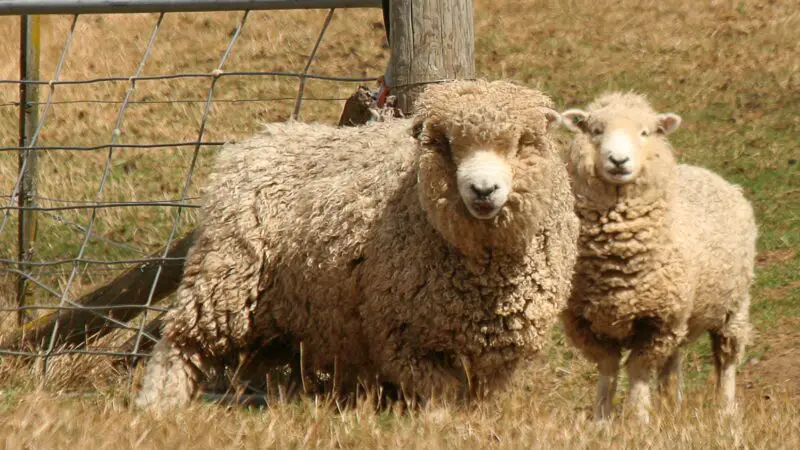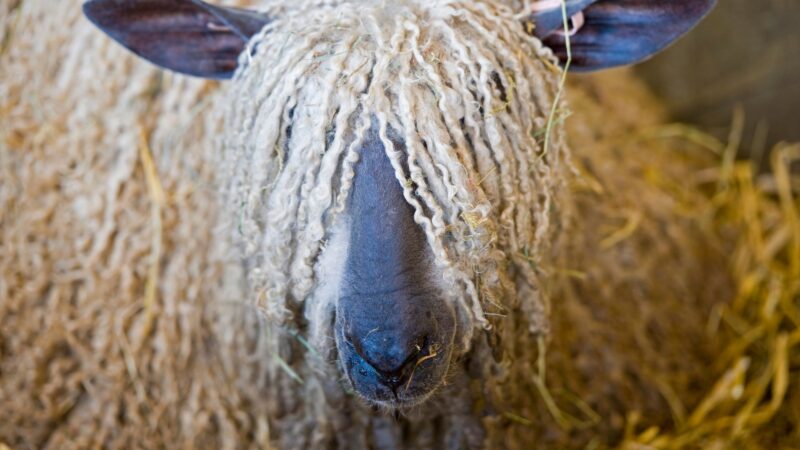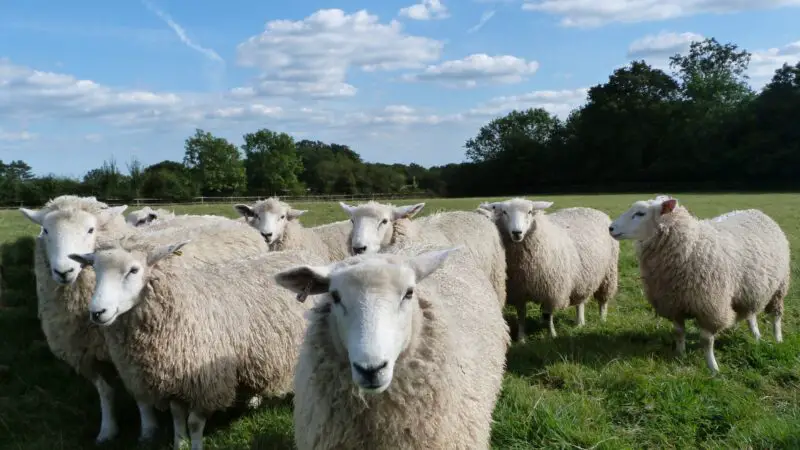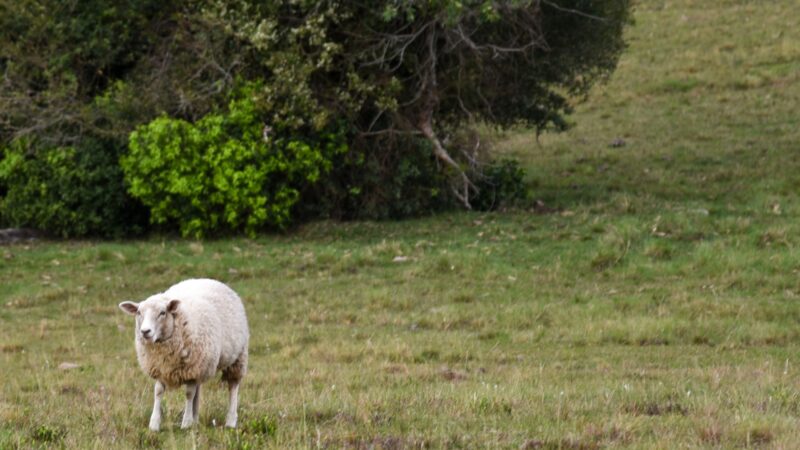Sheep wool, also called fleece, is not that popular in the United States in terms of world production. But then, it does not necessarily mean that raising sheep for wool is not a good idea.
On the contrary, the low competition in the wool industry is an advantage. You can sell sheep wool in large amounts for a specific price or sell them partially.
Raising sheep for wool is profitable since wool can be sold at various stages. Each stage requires different kinds of work, though. This means that some stages need more time than others. Earning profit from sheep wool also depends on the demand, and the expenses are usually high only in the first year.
Wool sheep farming does not only require skills in the task and financial aspects. The first thing you should know is the right sheep breed to raise for wool. There are more than 1,000 sheep breeds in the world, and about 60 of them are in the United States. Here are 10 wool sheep breeds and very important facts about their wool production.
10 Best Sheep Breeds for Wool
1. Booroola Merino Sheep

Place of Origin
The Booroola Merino sheep breed originated in Cooma, Australia. It was developed by Jack and Dick Seears of Booroola farm using the Merino breed from Spain. In 1958, the couple gave a quintuplet ram to the Commonwealth Scientific and Industrial Research Organization (CSIRO), which continued the development of the Booroola Merino breed.
Appearance
Booroola Merino sheep have a very striking appearance due to their long curled horns in rams and ewes. Both sexes have very white, thick, and fluffy wool all over their bodies and the upper part of their legs, especially the front ones.
Their face is white and has no wool. However, some strains are blinded by the loose and long wool on their forehead.
Height
There are no official records stating the height of Booroola Merino sheep, except that they are quite shorter than most wool sheep breeds.
Weight
Booroola Merino sheep are small and lightweight, and adults weigh only between 90 and 130 lbs (40.8 and 58.9 kilos).
Lifespan
Booroola Merino sheep can live from 10 to 12 years, just like most sheep breeds.
Temperament
There is not much written about the temperament of Booroola Merino sheep. But generally, they are considered calm and docile.
According to a study, Merino sheep and lambs are moderately heritable. Their behavior is not related to age and type of birth, but rather to the contemporary group or those sheep belonging to the same year.
- Wool Type: Exceptionally fine, very soft, and superior quality
- Staple Length: 2.6-3.9 inches (6.6-9.9 cm)
- Fiber Diameter: 18-23 microns
- Wool Weight: 9-15 lbs (4.0-6.8 kilos)
- Wool is Best Suited For: Blankets, clothes, and other knitted garments
2. Delaine-Merino Sheep
Place of Origin
The Delaine-Merino sheep is another strain of the Merino breed and is commonly found from North to South borders, including California, Iowa, Texas, New Mexico and. Ohio.
Generally speaking, there are 3 types of Merinos – the A-type, B-type, and C-type. The Delaine is considered the C-type and is the most practical to breed among all the types.
Appearance
Delaine-Merino sheep have smooth bodies and no wrinkles, unlike other Merinos. Despite having short necks, some specimens have one or two thick folds on the neck, at the back of their shoulders, and thighs.
Interestingly, this unique characteristic allows them to produce more wool. These folds will gradually disappear as the sheep age.
Height
Merino sheep, in general, are about 2 feet tall.
Weight
Mature Delaine-Merino rams weigh 175-235 lbs (79.4-106.6 kilos), and mature ewes with full fleece weigh about 125-180 lbs (56.7-81.6 kilos).
Lifespan
Delaine-Merino sheep have a lifespan of 10-12 yrs and can still be productive despite their old age.
Temperament
Like most Merino sheep breeds, Delaine-Merino sheep are considerably calm, gentle, and easy to manage. They can adapt well even to mostly harsh weather conditions and are friendly to people and other animals.
Despite being horned sheep, they are not known for being aggressive and don’t easily get excited. Ewes are also great mothers.
- Wool Type: Soft, ultra-fine, and strong
- Staple Length: 2.5-4 inches (6.35-10.2 cm)
- Fiber Diameter: 17-22 microns
- Wool Weight: 9-14 lbs (4.0-6.35 kilos)
- Wool Best Suited For: Various clothing and even underwear
3. Lincoln Sheep

Place of Origin
The Lincoln sheep originated in Lincolnshire County, England in the early 1800s. This British sheep breed was first imported into the US during the latter part of the century.
The present Lincoln sheep is a product of crossing Leicester Longwool and the original breed. The Livestock Conservancy currently lists the Lincoln sheep as “Threatened.”
Appearance
Lincoln sheep have very broad and wide bodies that are heavily covered with white long wool. Some strains may have shades of black, gray, and silver.
Also called the Lincoln Longwool, this extremely sturdy sheep breed has a white face, long ears, and usually has wool on its hind legs. Both the rams and ewes are naturally without horns.
Height
There are no official records about the height of Lincoln’s sheep. But because they are referred to as the largest wool sheep breed in the world, this sheep is one of the tallest long-wooled sheep breeds.
Weight
Adult Lincoln rams weigh around 250-350 lbs (113.4-158.7 kilos)), and adult ewes have a weight range of 200-250 lbs (90.7-113.4 kilos).
Lifespan
The average lifespan of Lincoln sheep is about 6.5 to 12 years.
Temperament
Despite their enormous sizes, Lincoln sheep are generally docile, friendly, and smart. Rams are active foragers, while ewes are excellent mothers.
They are also alert and curious, making them a popular choice for hobbyists and farmers alike. With their very thick wool, these gigantic sheep are very well adapted to extreme weather conditions.
- Wool Type: Long but lustrous
- Staple Length: 8-15 inches (20.3-38.1 cm) – world’s longest wool sheep breed
- Fiber Diameter: 41.0 to 33.5 microns
- Wool Weight: 12-20 lbs (5.4-9.0 kilos) – heaviest among long-wooled sheep breeds
- Wool Best Suited For: Hand-knitted carpet yarns, rugs, and upholstery yarns
4. Romney Sheep

Place of Origin
The Romney sheep originated in Romney Marsh, a very large marshland in Kent, England, hence the name. This long-wooled sheep breed has been recognized in the country since the 1800s.
It was first imported to the US in 1904 by William Riddell and Sons of Oregon. The breed was also shipped to other countries, especially New Zealand
Appearance
Romney sheep have different standards in all countries. Nonetheless, they have a large frame size covered with white wool, a white masculine face, large eyes, and a very wide chest.
Their necks are not too long but all well set on their shoulders. Most strains have heavily wooled legs. Their muzzles and hooves are black. Both sexes have no horns.
Height
There are no official records stating the height range of Romney sheep. However, they are relatively taller than most long-wooled sheep breeds.
Weight
Mature Romney rams have an average weight of 250 lbs (113.4 kilos), and mature ewes can weigh between 175 and 200 lbs (79.4 and 90.7 kilos).
Lifespan
There are no official records regarding the lifespan of Romney sheep. Yet, rams are known for having a long life and can still be productive as they reach about 10 years old.
Temperament
Romney sheep are famous for their docile, calm, and friendly temperament compared to some other sheep breeds. They are also easy to handle and have a good disposition towards humans and other animals. This long-wooled sheep is a very hardy breed and can adapt well to a variety of environments, making them ideal even for beginners.
- Wool Type: Long, durable, and semi-lustrous
- Staple Length: 4.9-6.8 inches (12.5-17.5 cm)
- Fiber Diameter: About 29.30 to 36.19 microns (US)
- Wool Weight: 8-12 lbs (3.6-5.4 kilos)
- Wool Best Suited For: Blankets, carpets, and heavyweight apparel
5. American Cormo Sheep
Place of Origin
The American Cormo is a strain of the Cormo breed that was originally developed in Tasmania, Australia in the early 1960s. The name Cormo came from its parents’ names – Corriedale and Merino. The first Cormo was imported to the US in 1976 by Travis Jones, who crossed the breed with local wool sheep to create the American Cormo.
Appearance
Like its original Australian breed, American Cormo sheep have long white wool covering their sturdy bodies, with faces having no wool. This medium-sized sheep has a long, narrow head, small ears, and straight legs.
Both the rams and ewes have no horns and no shades of other colors. There are no special markings in identifying this sheep breed.
Height
There are no official records stating the height of American Cormo sheep, except that they are smaller than most wool breeds.
Weight
Mature American Cormo rams weigh 160-200 lbs (72.6-90.7 kilos), and mature ewes are about 120-160 lbs (54.4-72.6 kilos).
Lifespan
There are no records of how long American Cormo sheep can live. But then, the average lifespan of a sheep is 10-12 years.
Temperament
Like most sheep breeds, American Cormo sheep are docile, friendly, and considered easy keepers. Their small sizes also make them easier to manage as compared to larger breeds.
These open-faced sheep are also adaptable to harsh weather conditions. They are excellent foragers and have a high fertility rate. Ewes are exceptional mothers.
- Wool Type: Long, well-defined, and high-yield
- Staple Length: 2.5-4 inches (6.35-10.2 cm)
- Fiber Diameter: 18 to 23 microns
- Wool Weight: Average of 12 lbs (5.5 kilos)
- Wool is Best Suited For: Blankets, clothes, jackets, and jerseys
6. Blue-Faced Leicester Sheep
Place of Origin
The Bluefaced Leicester sheep originated in Northumberland, England during the early 1900s. Also called BFL, It is one of the three Leicester sheep breeds. The other two are the English Leicester Longwool and the Border Leicester, which is the parent of the BFL. This breed spread across the US in 1995, and the first natural BFL was born in 2002.
Appearance
Bluefaced Leicester sheep are predominantly white, but some strains may have a few black spots. They have broad muzzles, bright eyes, and Roman noses.
Their faces are blue, with no wool on the head and neck. Their backs are strong and long, while the hindquarters are broad and deep. Both sexes are hornless, with no wool on their legs.
Height
Bluefaced Leicester sheep have an average shoulder height of 36 inches (91.4 cm), while their overall height is around 46 inches (116.8 cm).
Weight
Mature Bluefaced Leicester rams weigh 200-250 lbs (90.7-113.4 kilos), and mature ewes weigh about 130-160 lbs (58.9-72.6 kilos).
Lifespan
There are no records about the lifespan of Bluefaced Leicester sheep. Nonetheless, they can live long as most sheep breeds, which is from 10-12 years.
Temperament
Bluefaced Leicester sheep are known for being docile, sweet, and easy to handle. They may show affection to their owners through their “sheep greetings.”
In some cases, ewes may also demand a scratch on their chin. On the other hand, some rams seem to be intimidating at first. But as days go by, they will show mild disposition.
- Wool Type: Long, soft, and semi-lustrous
- Staple Length: 3-6 inches (7.6-15.2 cm)
- Fiber Diameter: 24-28 microns
- Wool Weight: 2.5-4.5 lbs (1.1-2.0 kilos)
- Wool Best Suited For: Hand knitting, heavier knitwear, and outer garments
7. Panama Sheep
Place of Origin
Contrary to what people may think, the Panama sheep did not originate in Panama. Instead, it was developed in Muldoon, Idaho, and was named after the Panama–Pacific International Exposition held in San Francisco, California) where it was first presented in public. This breed was created by a Scottish immigrant named James Laidlaw in 1912.
Appearance
Panama sheep have large bodies and short legs that are heavily covered with thick white wool. Their faces are the only part that has no wool. Both sexes are without horns.
They look like the Columbia sheep breed (also one of the first breeds developed in the US) but are quite smaller. Panama sheep are ideal for both meat and wool production.
Height
There are no records about the height of Panama sheep but are considered to be as tall as the other breeds.
Weight
Panama rams weigh between 250 and 280 lbs (113.4 and 127.0 kilos), and full-grown ewes can weigh 180-210 lbs (81.6-95.3 kilos).
Lifespan
Panama sheep can live as long as 20 years of age.
Temperament
Panama sheep are particularly calm, gentle, and docile. Despite their enormous sizes, they are friendly to humans and animals and are not prone to fighting each other.
And because these sheep are also hornless, they are very easy to manage. Aside from wool and meat production, this sheep breed also makes great farm pets with other animals.
- Wool Type: Thick, heavy, and medium-grade
- Staple Length: 3 to 5 inches (7.6 to 12.7 cm)
- Fiber Diameter: 25-30 microns
- Wool Weight: 5.3 to 13.2 lbs (2.3 to 5.9 kilos)
- Wool Best Suited For: High-end clothing such as suits and fine knitwear
8. Rambouillet Sheep
Place of Origin
The development of the Rambouillet sheep started in France when Louis XVI bought more than 300 Spanish Merinos in 1786. The original breed was crossed with English long-wool breeds, and some of them were brought to Germany. The American Rambouillets were then used in developing the American Blackbelly sheep.
Appearance
Rambouillet sheep have thick white wool all over their body, head, and legs. Their faces have no wool, but some strains are blinded by the wool right above their eyes.
They are quite bigger than their Merino ancestors. Most rams have huge curved horns with ends almost touching their head. On the other hand, ewes are usually without horns.
Height
There are no records stating the average height of Rambouillet sheep. Yet, they are among the tallest wool sheep breeds.
Weight
Mature Rambouillet rams weigh 250-300 lbs (113.4-136.0 kilos), and mature ewes weigh between 150 and 200 lbs (68.0-90.7 kilos).
Lifespan
The lifespan of Rambouillet sheep is 10-12 years, but some rams can live a bit longer.
Temperament
Rambouillet sheep are a relatively quiet and calm breed. In general, they are friendly and enjoy human interaction.
Like their ancestors, this American breed is very unlikely to show aggression and will avoid fights as much as possible. But although they like interacting with humans, their horns can still pose danger, especially if you have kids.
- Wool Type: Fine, superior, and lustrous
- Staple Length: 2.5-4 inches (6.35-10.2 cm)
- Fiber Diameter: 18.5-24.5 microns
- Wool Weight: 8-18 lbs (3.6-8.2 kilos)
- Wool is Best Suited For: High-end clothing such as jackets and coats
9. Corriedale Sheep

Place of Origin
The Corriedale sheep originate in South Island, New Zealand. It was developed by an English man named James Little between 1880 and 1910 by crossing Leicester or Lincoln rams with Merino ewes. The breed then spread throughout Australia, Asia, Africa, and Europe. Corriedale sheep were introduced to the United States in 1914.
Appearance
Corriedale sheep are a large-framed breed with horizontal ears and dark hooves. Like most breeds, their bodies are covered with white wool, but their faces have none.
Some strains have black or blue spots, though. This dual-purpose breed has a black nose, a broad back, and well-muscled legs. Both sexes are polled or born without horns.
Height
There are no records stating the height range of Corriedale sheep.
Weight
Mature Corriedale rams weigh from 175 to 275 lbs (79.4-124.7 kilos), and mature ewes weigh from 130 to 180 lbs (58.9-81.6 kilos).
Lifespan
There are no records showing the average lifespan of Corriedale sheep, except that they tend to live long.
Temperament
Like their Merino parents, Corriedale sheep are known for being docile and moderately heritable. They have high levels of tolerance toward humans and new surroundings.
In short, this breed can easily adapt to various environments and make great pets, too. Not to mention, ewes have excellent mothering properties and a high fertility rate as well.
- Wool Type: Medium-grade, durable, and high-quality
- Staple Length: 3.5-6 inches (8.9-15.2 cm)
- Fiber Diameter: 31.5-24.5 microns
- Wool Weight: 10-17 lbs (4.5-7.7 kilos)
- Wool is Best Suited For: Medium-weight outer garments and felted floor mats
10. Debouillet Sheep
Place of Origin
The Debouillet sheep was developed in Tatum, New Mexico in the 1920s by a rancher named Amos Dee Jones. He took some Delaine Merinos from Ohio and crossed them with Rambouillet sheep.
In case you didn’t notice, the name Debouillet came from its parents’ names. Since then, this sheep breed has become popular across South America.
Appearance
Debouillet sheep are a medium-sized breed with a white, woolly appearance. They have a significantly broad head, a woolly forehead, long, droopy ears, and a short tail.
This American sheep breed has wool on its face and legs, too. Their well-proportioned body has dense and fine wool. Rams may or may not have horns, while ewes are hornless.
Height
No records are revealing the height of Corriedale sheep.
Weight
Mature Debouillet males weigh from 175 to 250 lbs (79.4 to 113.4 kilos), and mature females weigh from 125 to 160 lbs (56.7 to 72.6 kilos).
Lifespan
There are no records stating the average lifespan of Corriedale sheep, but you can expect them to live between 10 and 12 years.
Temperament
Debouillet sheep are known for being gentle and friendly to humans and other animals. They are generally docile, calm, and easy to handle.
This wool sheep breed is not easily frightened or agitated unless seriously threatened. Needless to say, Debouillets are hardy and well-suited to different weather conditions. Lambs need less aid in the pasture.
- Wool Type: Fine, elastic, but quite greasy
- Staple Length: 3-5 inches (7.6-12.7 cm)
- Fiber Diameter: 18.5-23.5 microns
- Wool Weight: 10-18 lbs (4.5-8.2 kilos)
- Wool is Best Suited For: Clothing, blankets, and other similar textiles
Related Questions
Which Sheep Breed Is Famous for Its High-Quality Wool?
The most famous sheep breed for high-quality wool is the Merino. Based on estimates, Merinos comprise more than 50% of sheep in Australia, which is the largest exporter of wool in the world.
Aside from Australian Merino, the other sheep breeds that are also known for their wool include the Blue Faced Leicester, Corriedale, and Rambouillet.
What Sheep Has the Most Expensive Wool?
The Merino breed has the most expensive sheep wool in the world. Merino wool is the world’s second most expensive wool, next to vicuna wool, which comes from the vicuna, the smallest member of the camel family. So far, the price of Merino wool is around $11.50 per ounce, and a single whole ball of yarn can cost as much as $40.
Is Raising Sheep for Wool Profitable Than Goats?
Both the sheep and goat can be profitable when it comes to raising them for wool. Yet, there is no direct answer as to which animal can earn more as it depends on several factors.
In general, goats are more profitable than sheep since they grow faster. But then, they are noisier and more active than sheep, making them more difficult to handle.
On the other hand, sheep are more profitable than goats if you have a wide grassy field. Note that sheep eat grass more than goats do, and feed is the most expensive part of the investment.
And although Cashmere wool is lighter and softer than Merino wool, the latter is more durable. More importantly, there are several sheep breeds to choose from.
Related: How Much Does a Sheep Cost? | A Guide to Buying Sheep
List of Sources
Temperament and Its Heritability in Corriedale and Merino Lambs
